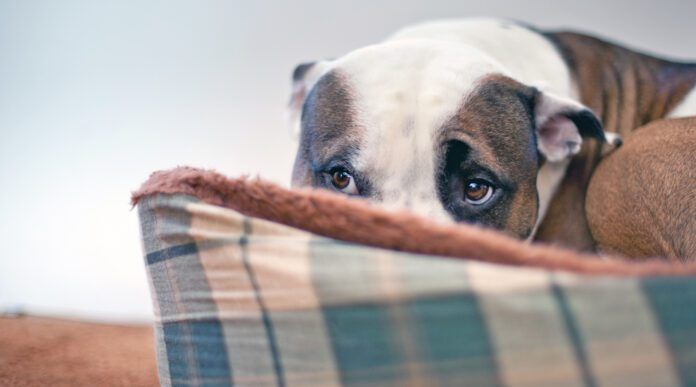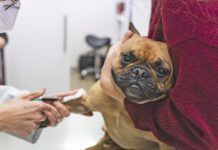Sileo gel for dogs may help dogs who seem to instinctively fear noise, or at a minimum, dislike certain noises. Those sounds can include vacuums, fireworks, thunder, any appliance that beeps, and more.
Sileo (dexmedetomidine oromucosal gel) is the first FDA-approved treatment for dogs that experience noise phobias or anxiety. Whether your dog needs treatment, be it behavioral modification or medication, can depend on the severity of the reaction to the noise, the frequency your dog is likely to encounter that sound, and if it is easy for you to manage avoiding that noise.
Sileo gel acts as a sedative for dogs and a bit of a tranquilizer. Your dog is still aware, but he “doesn’t care” as much about the disturbing noise. The gel must be carefully given orally. It is best to give it without food or anything that might interfere with absorption. You should wear gloves to avoid getting it on your skin as you would absorb it yourself. It can lower blood pressure.
Sileo Dosing Chart
It is very important to follow the dosing chart below exactly when giving Sileo, which is a prescription medication. The Sileo syringe has a plunger and marks dots on it to help you accurately dose your dogs, i.e., a 27-lb dog would get three dots.
Zoetis’s Sileo dosage chart is based on weight. Your veterinarian will go over dosages with you prior to dispensing the medication. Each dot contains .25 mL of Sileo. Each mL contains .1 mg of dexmedetomidine hydrochloride. Note: Don’t administer more than is recommended for your dog. When Sileo was released in 2016, there were incidents of people overdosing their dogs. Follow instructions carefully.
Sileo Dosing Chart
| Dog Body Weight in Pounds | Dose in Syringe Dots |
|---|---|
| 4.4 to 12.1 | 1 |
| 12.2 to 26.5 | 2 |
| 26.6 to 44.0 | 3 |
| 44.1 to 63.9 | 4 |
| 64.0 to 86.0 | 5 |
| 86.1 to 110.2 | 6 |
| 110.3 to 137.8 | 7 |
| 137.9 to 166.4 | 8 |
| 166.5 to 196.2 | 9 |
| 196.3 to 220.5 | 10 |
Sileo should not be given to dogs with health problems or who are on other medications. Always let your veterinarian know about any other medications or supplements your dog is taking. Weakness, loss of balance, tremors, and urination can all be side effects that should be reported to your veterinarian.
Other Dog Noise Phobia Medications
Other medications are available that may be recommended by your veterinarian as off-label alternatives to help with noise sensitivities. These include trazadone and gabapentin, which can help with anxiety.
Managing Your Dog’s Noise Phobia
Before reaching for medication, evaluate your dog’s noise problem. Management is usually a part of how to handle noise phobias. Perhaps it is just the vacuum that drives him crazy. This can be handled by putting your dog outside, in your car in a crate, or in a quiet corner of the house when you vacuum elsewhere.
Storm responses can be trickier. Storms don’t always follow forecast timing. You may have thought you would be home and able to keep your dog company somewhere quiet during a storm, but the storm arrives an hour earlier than expected. A coworker’s Irish Setter was known to jump out of second-floor windows and then run to escape loud storms. Her dog came to work on predicted stormy days to keep him safe.
Fireworks tend to be scheduled so you can plan. Some people simply pack up around big firework holidays like the 4th of July and head for the middle of nowhere to camp for a few days. If you stay at home, with a known fireworks timetable, you can plan when to medicate your dog for best effect. Many military veterans with PTSD also react to firework sounds. Some towns are now pushing for silent or quiet light displays, such as with drones. You still get the beauty but without the bangs.
Understanding Dogs with Noise Anxiety
Many breeders work to expose their puppies to a variety of sounds as young pups. There are CDs as well as YouTube videos with sirens (some dogs howl at sirens), vacuums, fireworks, gunshots, etc. on them. Initially, play these at very low levels so as not to frighten the pups. Sound can gradually be increased.
Many puppy-evaluation protocols include checking for sound sensitivity. A sharp sound is made, and the response of each individual pup is recorded. A startle is expected (if the dog gives no response, I would be concerned about deafness). Ideally, a pup startles and then either goes to investigate or continues doing what it was. Running off and not wanting to come back is indicative of sound sensitivity.
Dogs of different heritages will often respond differently. For example, guardian breeds, like the Great Pyrenees and Rottweilers, tend to want to go investigate, which makes sense. Herding dogs, like the Australian Shepherd and Border Collies, will tend to want to move away. In “real life,” they would be moving their flock from danger. Terriers tend to charge in.
Behavior Protocols to Reduce Noise Phobias
While medications provide a crutch, it’s wise to use behavior protocols for reducing noise phobias in dogs. If you can, work with a behaviorist to draw up a plan for your individual dog.
“Flooding,” which is overwhelming your dog with the sound until he basically gives up and accepts it, is NOT recommended. It can easily lead to irreparable damage to your dog’s temperament and your relationship.
Desensitization is better. This starts with the offending sound at a very low level. Your dog needs to be able to move away. You try to pair the low-level sound with something the dog loves such as his favorite treats. This works best if done early in the development of this phobia. Once firmly established, it is harder to break. Gradually, you can increase the sound level if your dog stays calm.
The use of physical methods can help. Many owners swear by ThunderShirts and pressure wraps (a la Temple Grandin) to reduce anxiety. The use of earmuffs or ear wraps can also help reduce noises to a tolerable level.
You can also try “noise masking,” which adds sound to the environment to reduce the intensity of unwanted sound. It makes the scary sound more difficult to detect. With things like thunder and fireworks, they “tone down” the noise so it’s less starting to the dog.
Whole Dog Journal offers an online course in handling sound anxiety in dogs. Whole Dog Journal’s online course “Dogs and Noise Anxiety explains the secrets to helping your dog deal with storms, fireworks, loud motors, shrill-sounding appliances, and other ear-piercing noises.
Help Your Dog Avoid Noise
What can you do to avoid noise phobias? Start by looking for a puppy who has had noise exposures and who tested sound for noise reactions. Of course, that isn’t always possible.
If you notice your dog being anxious about certain sounds, act right away. Plan if you can help your dog avoid the noise. A friend’s dog recently became nervous about the washer. So, her dog must be in a quiet room at the other end of the house with the door closed when it is running.
If it is a sound that will be there frequently, work on desensitization. Remember, slow and steady! Don’t rush the process, proceed with baby steps. When you can’t avoid the noise, try to have your dog away and in a quiet, safe place. Anticipate noisy situations and apply a wrap or give medication ahead of time if possible.







I want help the dog get over the fear of the vacuum by rubbing liverwurst on the vacuum when it was not running a few times, and then putting liver worse on the vacuum when it was running. This was successful.
That is I once helped and it was liverwurst.
I have successfully used Sileo in combination with another med prescribed by our vet behaviorist to help my dog become accustomed to the sound and vibration of the Dremel for nail trims. Without it we couldn’t even come close to him. It truly provided the “I do not care” response as described in the article. It took a couple years but now he will sometimes allow me to do his nails without any medication. I hope others with noise sensitive dogs experience the good results with Sileo as we have. We give it two paws up.
i’m glad to hear this drug helped acclimate the dog to nail trims. i am wondering if something like this would also help with some home dental care. i do brush my dog’s teeth, but just noticed a tiny accumulation of roughness on one molar that will only get worse without attention. would it be an irresponsible use of this drug to administer a dose every few months for dental upkeep and nail trims?